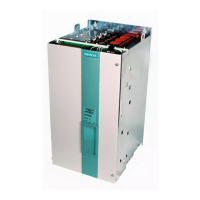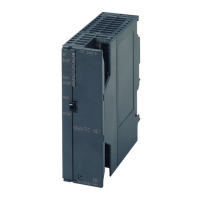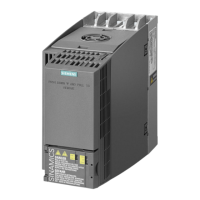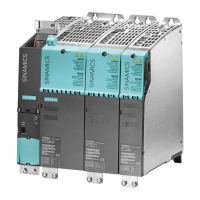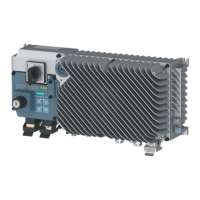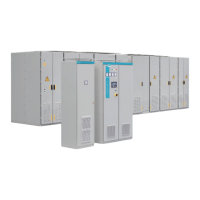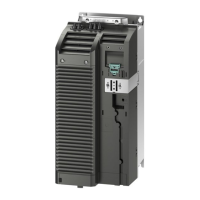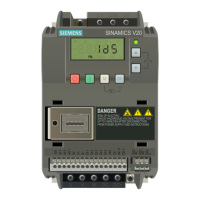Connection 09.02
3-52 Siemens AG 6SE7087-6AK85-1AA0
Rectifier/Regenerating Unit Operating instructions
3.8 12-pulse mode (only possible with the optional RS485 interface)
3.8.1 General information on 12-pulse mode, application
12-pulse operation is only possible as of Software Version 3.0. 12-pulse mode is implemented to reduce the
harmonic loading on the mains supply.
Two 6SE70 units
(rectifier/regenerating units) are connected in parallel on the output side and supplied on the
line side with two 3-phase AC supplies, galvanically isolated and with a phase offset of 30 degrees. One unit,
the "12-pulse master", controls the DC link voltage and provides the setpoint current for the other unit, the "12-
pulse slave".
On Software Version 3.2 and higher, 12-pulse operation
of an IR unit is also possible as a 12-pulse master and
12-pulse operation
of an infeed unit as a 12-pulse slave (infeed direction only).
Note
: A unit described here as a "slave" is a completely normal rectifier/regenerating unit with a CUR electronic
module and is only transformed into a "12-pulse slave" by the appropriate parameterization. The term "12-pulse
slave" must not be confused with a "parallel unit" for the connection of power sections in parallel because the
latter does not contain a CUR electronic module and has a different order No. (see Section 3.7).
The two 3-phase galvanically isolated AC supplies with a phase offset of 30 degrees are usually generated
using a transformer with 2 different secondary systems (e.g. Y y6 d5, i.e. primary winding: star, secondary
winding 1: star, secondary winding 2: delta). A transformer of this type will be referred to below as a "12-pulse
transformer".
To implement 12-pulse mode, the two rectifier/regenerating units must be coupled via a fast serial link. The
SST2 serial interface
for the basic unit is used for this purpose which is however only available as an RS485
interface once the optional A2 submodule (C98043-A1690) has been plugged into the A10 CUR electronic
module (C98043-A1680). See Sections 9.6 and 3.8.7).
The transmission protocol used for SST2 is the "Peer-to-Peer" protocol
.
3.8.2 Hardware requirements, configuration of the power sections
The sub-currents of the 3-phase AC supplies are decoupled
on the line side (line side with respect to the unit
terminals) through inductances (due to the secondary leakage inductance of the 12-pulse transformer,
commutating reactors and in the regenerative direction also due to the leakage inductance of the
autotransformers, if present).
Note:
A 12-pulse transformer alone is not always sufficient for decoupling because the two secondary windings
of the transformer are magnetically coupled. When the "12-pulse master" and the "12-pulse slave" are directly
supplied from a "high-power" 12-pulse transformer (i.e. without the intermediate connection of commutating
reactors), the DC link currents (in non-pulsating operation) each comprise 30 degree current blocks because at
intervals of 30 degrees, a commutating process takes place from secondary winding 1 to secondary winding 2
or vice-versa. Only if you use a 12-pulse transformer with sufficiently large secondary leakage inductances
(or
low magnetic coupling between secondary winding 1 and secondary winding 2) or if you use a " double-tier
transformer", in which no magnetic coupling
exists between the two secondary voltage systems, is it possible to
dispense with additional commuting reactors
.
The following points must be complied with
:
• Supply of the power sections of the 12-pulse master and the 12-pulse slave from galvanically isolated
3-phase AC systems
• Decoupled infeeds - i.e. commuting reactors after
the 12-pulse transformer or 12-pulse transformer with
sufficiently large secondary
leakage inductances (or low magnetic coupling between secondary winding 1
and secondary winding 2) or use of a "double-tier transformer".
• Identical inductances in the 12-pulse master and 12-pulse slave power section branches.
• Identical voltage levels at the 12-pulse master and 12-pulse slave, otherwise with a control angle of 0
degrees, this will cause unequal current division (with a control angle of 0 degrees, closed-loop control is not
possible - the unit with the higher voltage level carries more current).
• With Ud reduction, current asymmetry (as a result of a control angle of 0 degrees and differing voltage
levels) can be prevented or considerably reduced.
• An output reactor must not
be used in the DC link.
AoteWell Automation Sales Team
Buy Siemens PLC HMI Drives at AoteWell.com

